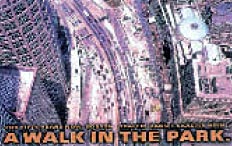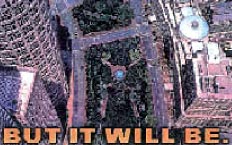 |
| New
Space for the Creation of Cities - Deep
Underground |
|
 |
 |
Description of the
main content of basic policies regarding public use of the Deep Underground |
 |
These become the
compliance requirements for authorization of the use of the Deep Underground
and also indicate the course of action for national policy |
|
 |
 |
 |
| I |
Basic
criteria related to the smooth execution of projects for
the public interest in the Deep Underground |
| |
- These criteria
determine whether a project utilizing the Deep Underground
is for the public interest and what items are necessary
in order to carry out the project smoothly. |
| 1. |
Projects that are for the
public interest |
| |
| · |
Projects that contribute to
the efficient, beneficial preparation of social capital,
such as shortening the time-period of coordination of
rights and selection of rational routes, etc. |
| · |
Projects that contribute to
the realization of high quality urban space such as restoring
of greenery and restful small waterways by moving aboveground
facilities underground. |
|
|
 |
 |
 |
 |
 |
| The project in Boston,
USA known familiarly as "The Big Dig" is making progress
in restoring greenery by moving expressways underground. |
|
 |
| 2. |
Policies for the smooth execution of
projects |
| |
| · |
The undertaking enterprise should
disclose information from the concept and planning stage
of the program. And in order to achieve accountability
efforts to spread information and explanations to residents
should be made at the realization stage. |
| · |
Adequate adjustments regarding necessary
surface access should be planned with the managers of facilities
that are on the surface or in the shallow underground. |
| · |
Efforts should be made to take advantage
of and undertake partnerships with land expropriation systems
and city planning systems. |
| · |
Appropriate responses should be
made regarding compensation for damages if wells dry up, etc.
and to return conditions to their former state after the end
of the project. |
|
|
| II |
Basic
criteria regarding the appropriate, rational use of the Deep
Underground |
| |
- Determination of the
optimal ways to use the Deep Underground, which has only a limited
amount of space. |
| 1. |
Basic rules to use Deep Underground
space |
| |
| · |
The space is put into order by stipulating
usage depths for each facility that will face the same direction. |
| · |
Manned facilities will be placed
in upper levels as much as possible. |
| · |
Large scale access sections to aboveground
areas will be placed, as much as possible, in the parts
of the Deep Underground that are in the vicinity of public
land where it is relatively easy to secure access space. |
| · |
With respect to commonizing, adjustments
between projects will be carried out while keeping in
mind issues such as the burden of expenses and management
of maintenance. |
| · |
Usage adjustments will be carried
out from the project concept stage by utilizing the Deep Underground
Use Council, and applications for the authorization of use of
the Deep Underground will be carried out after adjustments have
been made. |
| · |
The Regional Development Bureau
(covering the Kanto / Kinki / Chubu areas) is in charge
of the operation of the Deep Underground Use Councils. |
|
 |
 |
| 2. |
Measures to be taken when there is
danger of difficulties occurring in the case of structures such as
existing facilities |
| |
| · |
When there is danger of difficulties
impeding the structures and/or functions of nearby facilities,
appropriate measures should be undertaken utilizing the applicable
Deep Underground Use Council. |
|
|
| III |
Ensuring
safety, preserving the environment, and other criteria that
must be taken into consideration for the public use of the Deep
Underground |
| |
- Certain criteria must
be taken into consideration by enterprise operators when making
use of the Deep Underground. |
| 1. |
Ensuring safety |
| |
| · |
Adequate safety measures should
be put in place regarding (1) fire / explosion, (2) earthquake,
(3) flooding, (4) power outage, (5) first aid / rescue operations,
and (6) prevention of crime. |
|
 |
 |
| 2. |
Preservation of the environment |
| |
| · |
Environmental Impact Assessment
procedures should be carried out. These procedures should
take account of problems such as (1) water intake problems
/ ground subsidence due to declines of ground water levels
/ water pressure, obstruction of flow of subsurface water,
and quality of subsurface water, (2) ground movement,
(3) chemical reactions of strata, and (4) the disposing
of excavated materials. |
| · |
Appropriate environmental countermeasures
should be carried out even in the case of projects that are
not the subject of Environmental Impact Assessment procedures. |
| · |
Measures, including the monitoring
of facilities in service, should be taken for early discovery
of anything that cause impacts on the environment. |
|
 |
 |
| 3. |
Steps to enhance barrier-free nature
and improve amenities |
| |
| · |
Besides installing elevators
and escalators, comprehensive barrier-free advances should
be undertaken, including countermeasures in human relations
such as enhanced cooperation. |
| · |
The interior environment, including
heat, air, and lighting, should be managed appropriately,
in order to create an internal environment that is comfortable
and safe. |
|
 |
 |
| 4. |
Collection / application of safety
/ environmental and other information |
| |
| · |
Safety / environmental and other
information should be collected in cooperation with national
and local government/public bodies and enterprises, and steps
should be undertaken to establish safety measures and develop
Environmental Impact Assessment techniques. |
|
 |
 |
| 5. |
Other criteria which should be considered
in connection with the public use of the Deep Underground |
| |
| · |
Consideration should be given to
the protection of cultural assets and impacts on the structures
and functions of national and public property. |
|
|
| IV |
Other
important criteria regarding public use of the Deep Underground |
| |
- Criteria should be
formulated for future national initiatives related to the utilization
of the Deep Underground. |
| 1. |
Promotion of the development
of technology |
| |
| · |
The national government will
attempt to encourage private-sector technological development
by putting together a vision for the development of technology. |
|
 |
 |
| 2. |
Information gathering / disclosure
regarding the use of the Deep Underground |
| |
| · |
The national government promotes
preparation of information systems related to information
of the soil and on facilities installed underground. |
|
|
 |
 |
 |
| Shindo-Kun |
|
|
|